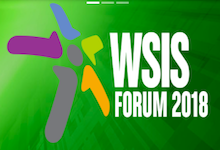Child online protection ecosystem: Platforms, services and tools
23 Mar 2018 09:00h - 10:45h
Event report
[Read more session reports from the WSIS Forum 2018]
The moderator, Dr Hadi Shahriar Shahhoseini, from the Iran University of Science and Technology, introduced the topic and welcomed the audience. This session aimed at providing the perspective of different stakeholders in an effort to create a child online protection ecosystem. The panel included representatives of the private sector, government, academia, – all from Iran – and one international organisation, the International Telecommunication Union (ITU).
Dr Ibrahim M J Aldabal, from the Council Working Group on Child Online Protection at the ITU, explained the fundamentals of the ITU’s Child Online Protection initiative (COP). Aldabal mentioned the evolution of the process which led to the formulation of COP and mentioned some of the challenges children have to face on the Internet. There is a missing ‘safe zone’ for children. Terrorists and drug dealers even use games for recruitment and dealing. In conclusion, he urged participants to utilise the COP as much as possible in their daily work.
Mr Amirhossein PanahiNaeini, from the ICT Research Institute, focused on the challenges and legal requirements of child online protection in general and in the COP ecosystem in Iran. PanahiNaeini talked about the principles governing the development of children’s cyberspace services; the role of the Iranian Ministry of information and communication technology (ICT) in the implementation process; and the visions, strategies, objectives, and metrics used.
Mr Seyed Hadi Sadjadi, from the Iran Information Technology Organization, presented the KOVA project (the champion project in the WSIS prizes 2018). This project will finish its first phase, in which 1 000 schools are involved, in May 2018. The next phase, starting in September 2018, will increase this number to 4 000 schools. The main goals of the project are:
-
to be a source of information about security and safety in cyberspace for children, youth, parents, and educators;
-
to increase the knowledge of teachers and to educate students about the culture of using social media;
-
to improve safe and secure use of the Internet and social media; and
-
to make parents better equipped with information in order to educate their children
Sadjadi then talked about some of the issues identified by the KOVA project and described their challenges, achievements, and solutions. The issues mentioned were: social networks, mobile apps, games, and Internet access.
The practical example of a child online protection ecosystem in Iran was presented by Mr Mazdak Mohtasham, from Anarestan. The Anarestan company has developed a whole set of products and services designed to protect children. This ecosystem comprises SIM cards, tablets, kid-friendly Internet and search engine, voice-based content, marketplace, robotics, and gaming leagues. The whole system is segmented for different age groups and provides whitelisted, positive, and educational content for them. After two years of implementation, the system has 4.5 million subscribers and 9 800 apps, books, and audio files. It involves 4 000 schools and over 300 contracted publishers. Mohtasham informed the session that Anerstan is ready for international cooperation and mentioned some opportunities such as transferability, collaboration with content providers, and hardware modifications. He then reiterated the main global challenges and asked that the Internet be made kids-friendly. He gave a parallel to the code of conduct ‘women and children first’. He felt that this was missing in the cyberworld. Mr Abbas Mohammadkhanighi Asvand, from Dorsa, briefly introduced a Dorsa family company which is another child online protection ecosystem in Iran. Asvand stressed that there is a lack of quality content and services in Farsi, and a lack of transparent and comprehensive law for the production and distribution of digital services and content.
The discussion with the audience tackled several questions. What are the ITU‘s actions regarding the growing number of games promoting xenophobia especially toward people from the Middle East? Would it be possible to have an ITU watchdog for this matter? Aldabal pointed out that the ITU has no mandate for such activities and cannot question the content of communications in its member states. Another batch of questions tackled some technicalities of the Anarestan ecosystem. The audience was interested in how new content is provided and promoted; openness and pricing; details about customisation of access for different age groups, and control mechanisms used for public spaces.
By Radek Bejdak
Related topics
Related event

